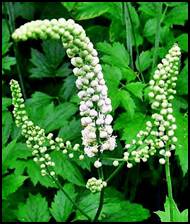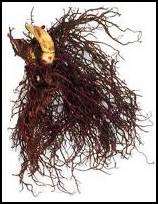
Black Cohosh
SCIENTIFIC NAME:(Actaea racemosa and Cimicifuga racemosa)
A member of the buttercup family, Black Cohosh is a perennial plant that is native to North America. It got many of its names from the fact that insects avoid it. It is the root of the plant that preparations are made from.
Common Names:
Black Snakeroot, Macrotys, Bugbane, Bugwort, Rattleroot, Rattleweed

Uses:
Black cohosh was used in North American Indian medicine for malaise, gynecological disorders, kidney disorders, malaria, rheumatism, and sore throat. It was also used for colds, cough, constipation, hives, and backache and to induce lactation. In 19th-century America, black cohosh was a home remedy used for rheumatism and fever, as a diuretic, and to bring on menstruation. It was extremely popular among a group of alternative practitioners who called black cohosh "macrotys" and prescribed it for rheumatism, lung conditions, neurological conditions, and conditions that affected women's reproductive organs (including menstrual problems, inflammation of the uterus or ovaries, infertility, threatened miscarriage, and relief of labor pains). However, today it is used mainly for hot flashes and other menopausal symptoms.Applications:
Capsule:
Follow the directions on the bottle.






